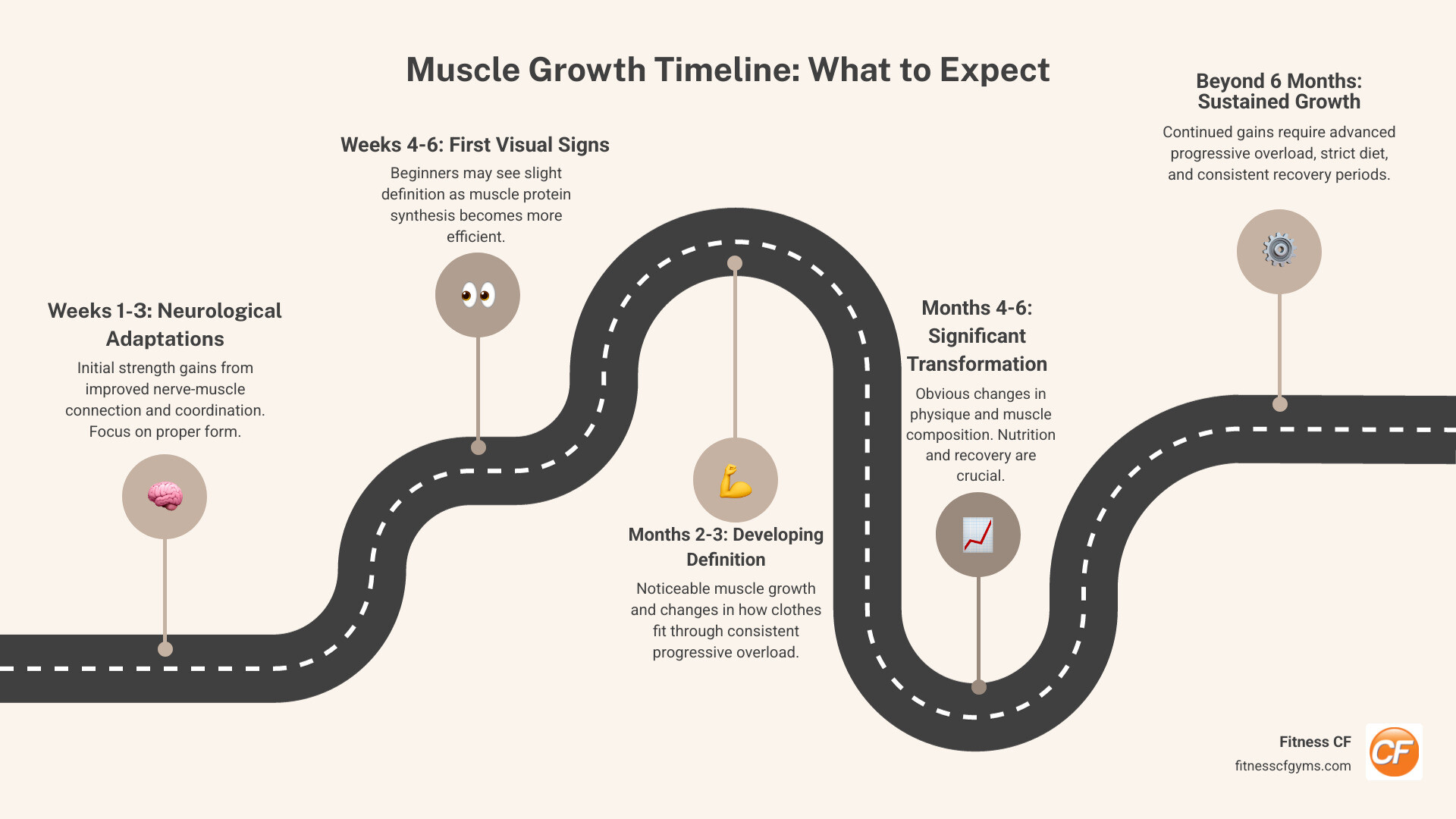The Journey to a Stronger You
How long does it take for muscles to grow is one of the most common questions people ask when starting their strength training journey. The answer isn’t simple, but research provides a general timeline.
Quick Timeline for Muscle Growth:
- 2-3 weeks: Strength improvements and better coordination
- 4-6 weeks: First visible muscle changes (for beginners)
- 2-3 months: Noticeable muscle definition
- 4-6 months: Obvious changes to physique and muscle composition
- Muscle gain rate: 1-4 pounds per month (beginners) vs. 0.5 pounds per month (experienced lifters)
Building muscle is a marathon, not a sprint, requiring patience, consistency, and realistic expectations. Your muscles are the most adaptable tissue in your body, but this adaptation happens gradually. You’ll start feeling stronger and more energetic within a few weeks, even before you see obvious visual changes.
Strength training offers incredible benefits beyond aesthetics. It improves posture, makes daily activities easier, boosts metabolism, and helps prevent age-related muscle loss. These health benefits start almost immediately, so focusing on how you feel can be as motivating as how you look.

How long does it take for muscles to grow terms explained:
- how to lose fat and gain muscle
- muscle building tips for fat guys
- nutrition tips for building muscle and losing fat
The Science Behind Muscle Growth (Hypertrophy)
To understand how long does it take for muscles to grow, you need to know the science of hypertrophy. When you challenge your skeletal muscles with resistance training, you create tiny, controlled damage to your muscle fibers called exercise-induced micro-tears. This is a normal and necessary part of the process.
These micro-tears trigger a complex repair process orchestrated by specialized satellite cells. When these cells detect damage, they multiply and fuse with your existing muscle fibers. This fusion adds new nuclei that act like protein factories, kicking muscle protein synthesis into high gear. Your body lays down new protein threads (actin and myosin) that make your muscle fibers thicker and stronger than before. This repair and rebuild cycle is what creates stronger muscle tissue formation.
Your hormones play a starring role, too. Testosterone, growth hormone, and insulin-like growth factor work together to regulate how cells respond to exercise, promote protein synthesis, and help create new blood vessels to feed your growing muscles. Research on the stimuli and sensors that initiate skeletal muscle hypertrophy shows just how intricate this process is, with multiple pathways working to detect exercise stress and respond with muscle growth.
How Your Body Fuels Muscle Repair
Building muscle is like constructing a house—you need the right materials and enough energy.
Amino acids are your body’s building blocks. When you eat protein, it’s broken down into essential amino acids, which your body uses to repair micro-tears and build new muscle tissue. Without enough amino acids, your muscles can’t rebuild effectively.
Your body also needs a caloric surplus for energy. Building new tissue is an energy-intensive process. If you’re not eating enough calories, your body may prioritize other functions over muscle building.
Blood flow ties everything together. Your circulatory system delivers oxygen, nutrients, and amino acids to your working muscles while carrying away waste products. Good blood flow is essential for optimal repair and growth. This entire process happens around the clock, even while you sleep. To learn more, check out The Science of Fitness: How Exercise Impacts Your Body.
So, How Long Does It Take for Muscles to Grow? A Phased Timeline
Your body’s timeline for muscle growth is unique, but most people experience a typical pattern. Understanding these phases can help you stay motivated and recognize progress.

Consistency matters far more than intensity. Steady, persistent effort yields better long-term results than sporadic bursts of extreme activity. Individual results will vary based on factors like age, training history, nutrition, and genetics, but the general phases of growth are consistent.
The First Month: Neurological Gains and Feeling Stronger
In the first few weeks, you’ll feel significantly stronger before you see visible changes. This is due to your nervous system becoming more efficient. During these initial 2-3 weeks, your brain improves its communication with your muscles. This neuromuscular adaptation allows you to lift heavier weights and improves your coordination.
You’ll notice your endurance increasing and daily tasks becoming easier. These initial strength gains happen because your body is recruiting more muscle fibers more efficiently, not because you’ve built significant muscle tissue yet. This phase is highly motivating as your body prepares for the growth to come.
Months 2-3: The First Visible Changes
After about 4-6 weeks of consistent training, you’ll start noticing the first initial visual results. The changes might be subtle, like firmer arms or a hint of shoulder definition. You might also find that your clothes fit differently, with shirts feeling snugger around the arms or chest. This often happens before the scale changes much, since muscle is denser than fat.
Beginners often experience rapid “beginner gains,” building 1-2 pounds of muscle per month during this phase as their bodies respond enthusiastically to the new stimulus. The slight muscle definition you see is just the beginning. For more strategies, check out How to Build Muscle Mass Simply and Guaranteed.
Months 4-6 and Beyond: Noticeable Muscle Definition
By this phase, the obvious changes to your physique become undeniable, and you’ll see significant muscle composition changes in the mirror. At this point, continued progressive overload is crucial. Your body has adapted, so you need to keep challenging it with heavier weights, more repetitions, or new exercises.
Expectations should shift slightly here. Advanced lifter gains typically slow to about 0.5 pounds of muscle per month. This isn’t discouraging; it represents high-quality, dense muscle that makes a significant visual impact. The timeline for truly noticeable definition varies, but most people see dramatic changes by the six-month mark. This phase teaches a marathon mindset, where the rewards of strength and confidence compound over time.
Key Factors That Influence Your Muscle-Building Rate
While there’s a general timeline for how long does it take for muscles to grow, no single timeline fits all. Numerous personal factors influence how quickly you’ll see results. Understanding these variables helps set realistic expectations.
Training Experience, Frequency, and Intensity
Your fitness background plays a huge role. Beginners often see rapid improvements—so-called “newbie gains”—because their bodies respond enthusiastically to the new training stimulus. Experienced lifters, whose bodies have already adapted, find that further gains are more challenging and require more strategic effort.
The progressive overload principle is key for everyone. This means gradually increasing the challenge over time by adding weight, doing more reps, or reducing rest time. Without this progression, your muscles have no reason to grow stronger.
Most experts recommend strength training two to three times per week, targeting major muscle groups at least twice. Sessions of 20 to 30 minutes focusing on compound movements are effective. A typical approach is two to three sets of eight to fifteen repetitions per exercise. For more on training strategies, explore What is Strength Training and What Are Its Benefits?.
Nutrition: The Role of Protein and Calories
You can’t out-train a poor diet. Nutrition provides the energy for workouts and the raw materials for muscle growth. Building muscle requires a slight caloric surplus of about 250-500 more calories than you burn daily. This fuels the muscle-building process without excessive fat gain.

Protein is crucial. The National Strength and Conditioning Association recommends 1.2 to 2.2 grams of protein per kilogram of body weight for those actively building muscle. Quality sources include lean meats, fish, eggs, dairy, beans, lentils, and tofu. Spreading protein intake throughout the day provides a steady supply of amino acids for muscle repair. Carbohydrates, healthy fats, and proper hydration are also vital for fueling workouts and supporting hormone production. For more, see our Nutrition Tips for Building Muscle and Losing Fat and this guide to High-protein foods.
Age, Hormones, and Genetics
These three factors influence your muscle-building timeline. After 30, we naturally lose muscle mass through sarcopenia, a Natural age-related progressive loss of muscle mass. Consistent strength training can dramatically slow this process at any age.
Hormones like testosterone and growth hormone are key. Men typically have more testosterone, which is why they often build mass more quickly. However, women can and do build significant muscle. Genetics also determine your potential, but everyone can get stronger with consistent effort. Research shows that men and women have similar training responses to strength training.
The Critical Role of Sleep and Recovery
This is an essential, often overlooked, piece of the puzzle. Muscles don’t grow during your workout; they grow during rest and recovery. When you sleep, your body repairs the microscopic tears in your muscle fibers, making them stronger and larger. Growth hormone release peaks during deep sleep, making it crucial for muscle development.
Aim for seven to nine hours of quality sleep nightly. Recovery between workouts is also important, requiring 24 to 48 hours for muscles to repair. Active recovery like walking or gentle yoga can promote blood flow and speed up the process. Overtraining can halt progress and increase injury risk, so listen to your body. Rest and recovery are critical for athletes and anyone looking to build muscle.
The Other Side of the Coin: Understanding Muscle Atrophy
While we’ve focused on how long does it take for muscles to grow, it’s also important to understand its opposite: muscle atrophy, or muscle loss. The sobering truth is that muscle loss often happens much faster than muscle gain.
Muscle atrophy is a natural adaptation. If your body perceives that muscles aren’t being used, it begins to break them down to redirect energy and resources elsewhere. The most common causes are:
- Inactivity: Stopping a regular strength training routine or becoming sedentary for extended periods sends a signal to your muscles that they are no longer needed at their current size.
- Injury: Immobilizing a limb, such as with a cast, can lead to rapid and dramatic muscle shrinkage.
- Aging: Sarcopenia is the natural, progressive loss of muscle mass that begins after age 30. Strength training is crucial for slowing this process.
Strength loss can be noticeable within just one to two weeks of stopping a routine, often due to neuromuscular deconditioning. After three to four weeks of inactivity, you’ll likely experience more significant decreases in both muscle strength and size. Understanding What is muscle atrophy? helps prevent it. The key is consistency. Maintaining muscle is always easier than rebuilding it from scratch, which is why a sustainable fitness routine is so valuable.
Frequently Asked Questions about Muscle Growth
Here are answers to some common questions about how long does it take for muscles to grow and what to expect on your journey.
How can I tell if I’m building muscle if I don’t see it?
Your body is changing long before your eyes can see it. The most obvious signs are non-visual. You’ll notice increased strength, meaning you can lift heavier weights or complete more reps. Daily activities like climbing stairs or carrying groceries will feel easier, and your endurance improves. Another key indicator is how your clothes fit differently. Since muscle is denser than fat, you might find shirts are tighter in the shoulders or pants fit better, even if the scale hasn’t moved much.
Can cardio help with muscle growth?
While strength training is superior for muscle hypertrophy, cardio can play a supporting role. High-Intensity Interval Training (HIIT) can contribute to muscle growth, especially for beginners. More importantly, good cardiovascular health is crucial for muscle building. A strong heart and circulatory system improve nutrient delivery and waste removal, supporting faster recovery and better workout capacity. Cardio also helps with fat burning, which makes the muscle you’ve built more visible.
What are the most common muscle-building mistakes to avoid?
Avoiding common mistakes can put you ahead of the game. The biggest pitfalls include:
- Neglecting nutrition and sleep: Your muscles need adequate calories, protein, and rest to grow. Growth happens during recovery, not during the workout.
- Inconsistent training: Sporadic workouts won’t provide the regular stimulation your muscles need to adapt.
- Poor form: This reduces the effectiveness of exercises and significantly increases your injury risk.
- Not using progressive overload: If you don’t continually challenge your muscles, they have no reason to get bigger or stronger.
- Overtraining: More isn’t always better. Your body needs time to recover and rebuild between sessions.
For a more comprehensive guide, check out 11 Common Muscle Building Mistakes and How to Avoid Them.
Conclusion: Consistency is Your Greatest Ally
So, how long does it take for muscles to grow? The answer is individual, influenced by everything from your training experience to your sleep habits. However, a general pattern emerges.
You’ll feel stronger within a few weeks. Visible changes typically appear around the 2-3 month mark, with more noticeable muscle definition developing over 4-6 months of consistent effort. Beginners might gain 1-2 pounds of muscle per month, while experienced lifters may see closer to half a pound.
The real magic of strength training is that the benefits start long before you see major changes in the mirror. Improved performance, increased energy, and better posture show up within weeks. The recipe for success is simple: consistent strength training with progressive overload, adequate nutrition with enough protein and calories, and quality sleep and recovery.
Building muscle is a marathon, not a sprint. Focus on how you feel and celebrate performance gains, not just aesthetics. Every workout is an investment in your future self, building a foundation for lifelong health and vitality.
Ready to start your fitness journey? Explore the resources and support available at Fitness CF to build a stronger, healthier you. Start your journey with us.








